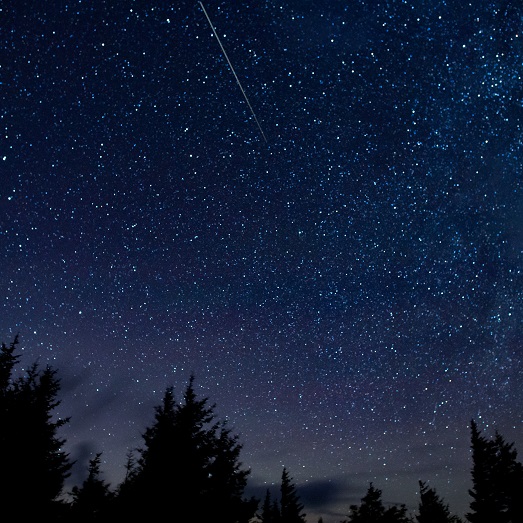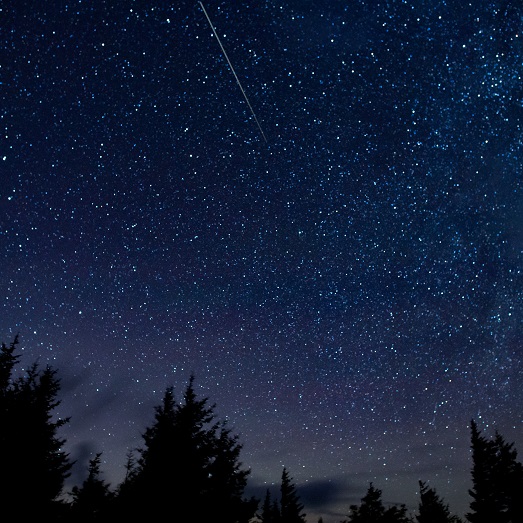 Web Content Display
Web Content Display

Meteor Shower
Tab Menu
 Web Content Display
Web Content Display

In addition to some large celestial bodies such as planets, dwarf planets, moons, asteroids and comets, our solar system also contains countless meteoroids and dust. When these small bodies enter the Earth's atmosphere at high speed, visible light will be emitted by air molecules being heated, forming what we called a meteor or shooting star. There are many meteoroids falling towards the Earth every day but most of them are too dim to be seen. We can only observe them in a dark area.
Since modern technology is still not capable of detecting meteoroids, meteor observation is almost a random attempt. Meteors often appear as sporadic lonely streaks that traverse somewhat random paths in the sky. However, there are some certain dates throughout the year where meteors appear more frequently and regularly. We call this repeatable meteor phenomenon as a "meteor shower".
 Web Content Display
Web Content Display
When the Earth meets the meteoroids left behind by a comet (some meteor showers have a parent of other celestial bodies but not comet) in the solar system, a meteor shower occurs. Comets are mostly composed of ice. They travel in the solar system periodically at very high speed. As they approach the Sun, the thermal radiation of the Sun peels off their surface materials, leaving a tremendous amount of meteoroids in their orbits. Therefore, multiple meteor streams are formed across the solar system. When the Earth encounters one of these streams, thousands of the meteoroids dash into the Earth's atmosphere, causing a meteor shower. Since the meteoroids share almost the same orbit with their parent comets, when they enter the Earth as meteors, they will originate from a certain point in the sky known as the "radiant". A meteor shower has a unique parent comet (but some comets can cause two meteor showers). It is named according to the constellation where the radiant of the meteor shower is located. For example, when the radiant sits at the constellation Perseus, we call the corresponding meteor shower event as the Perseid meteor shower.
The number of meteors of a meteor shower event is related to the number of meteoroids left by its parent comet. Meteoroids can be refilled when a comet is returned every time, but since comets have different lifespans, and the meteor stream can be perturbed by the gravitational force of the planets (especially Jupiter), it is difficult to predict how a meteor stream will behave when the Earth comes across it. Thankfully, after years of observation, astronomers are able to understand the characteristics of the major streams, thereby making reasonable predictions. For instance, there were several Leonid meteor showers known in the history that happened to be separated by 33 years, such as November 1833, November 1966 and November 1998 (including 1999 and 2001 too). This is due to the fact that its parent comet 55P/Tempel-Tuttle has an orbital period of 33 years. Therefore, it is anticipated that the next large-scale Leonid meteor shower will occur again near 2032, but the number of meteors in other years will be minimal.
 Web Content Display
Web Content Display
The term Zenithal Hourly Rate (ZHR) is used by astronomers to describe the activity of a meteor shower. It is the extrapolated hourly rate of meteors observable in an extremely dark and wide sky with the radiant located at the zenith. As the peaks of some meteor showers are very short, observers sometimes extrapolate the number of meteors observed in ten and a few minutes to an hourly number proportionally. Therefore, the Zenithal Hourly Rate cannot be regarded as the actual number of meteors visible in an hour. Yet, it can be used as a meaningful comparison between the activities of different meteor showers. For example, there are three major meteor showers every year, namely the Quadrantid meteor shower, the Perseid meteor shower and the Gemini meteor shower, which have the maximum ZHRs reaching 100 or even higher. Meanwhile, the maximum ZHRs of some weak meteor showers can be as low as some single digits.
 Web Content Display
Web Content Display
| Shower | Activity (D/M-D/M) |
Peak (HKT-D/M) |
Zenithal Hourly Rate (ZHR)^ |
Suggested Observation Period | Local Observation Condition* |
|---|---|---|---|---|---|
| Quadrantids | 28/12 – 12/1 | 4/1 05:00 | 80 | –– | Poor# |
| Lyrids | 14/4 – 30/4 | 23/4 03:40 | 18 | 23/4 00:30 – 04:30 | Favourable |
| η-Aquariids | 19/4 – 28/5 | 6/5 | 50 | 6/5 02:00 – 04:30 | Fair# |
| Southern δ-Aquariids | 12/7 – 23/8 | 31/7 | 25 | –– | Poor# |
| Perseids | 17/7 – 24/8 | 13/8 11:00 | 100 | 12/8 22:00 – 13/8 04:30 | Favourable# |
| Orionids | 2/10 – 7/11 | 22/10 | 20 | 22/10 02:00 – 05:00 | Fair |
| Leonids | 6/11 – 30/11 | 18/11 07:45 | 15 | 18/11 01:00 – 05:30 | Favourable |
| Geminids | 4/12 – 20/12 | 14/12 22:00 | 150 | 14/12 19:00 – 15/12 05:30 | Favourable |
Source of data: International Meteor Organization
^Zenithal Hourly Rate (ZHR) is an idealised maximum value, assuming the observer’s eyes are fully dark-adapted, the meteor shower radiant is at the zenith, there is no interference from moonlight or clouds, and the observation site has an unobstructed sky without light pollution. In reality, these ideal conditions are difficult to achieve in Hong Kong.
*Local Observation Condition is estimated by the effect of moonlight during maximum and whether the altitude of the radiant is favourable to Hong Kong. It is divided into five levels, which are "Excellent", "Favourable", "Fair", "Unfavourable" and "Poor".
Moonlight: Bright moonlight can obscure the relatively dim meteors. Since the number of faint meteors is much larger than that of the bright ones during a meteor shower event, the observation condition will become more unfavourable when the peak is closer to the day of the full moon.
Position of radiant: Radiant refers to the point in the sky where the meteors appear to originate, but it is not necessary for the meteors to start appearing from that point. When the radiant is near the horizon, many meteors will appear below the horizon where we cannot see. When the radiant rises to a higher position, we will be more likely to see the meteors that share the same origin and appear in any direction. The position of the radiant depends on the Earth's rotation (like sunrise and sunset) and the geographical position of the observer. The radiant of some meteor showers cannot reach a high altitude in the sky, including the Perseids and Quadrantids which are more suitable for observers in regions at higher latitude. These events can only reach the level "Favourable" at their best (marked with a symbol #). However, a "Favourable" or "Fair" event with a high ZHR value is more observable than an "Excellent" event with a low ZHR value.
